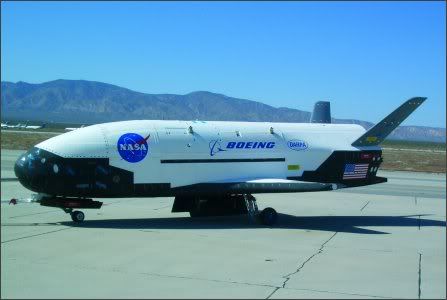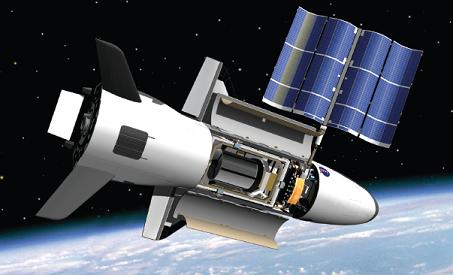NASA may have given up on spaceplanes for now, with the Shuttle soon to be replaced by old-school rocket stacks and capsules. But the US Air Force, it seems, still sees a need for spacecraft which can re-enter atmosphere and make a runway landing. Reports indicate that the X-37B unmanned spaceplane demonstrator will make its first orbital launch in November under USAF auspices.
According to Aviation Week, the "Orbital Test Vehicle" - built by Boeing's "Phantom Works" advanced-projects bureau - will be launched atop an Atlas V booster package from Cape Canaveral, taking a launch slot previously filled by a NASA moon reconnaissance mission.
NASA's original long-endurance X-37 orbiter concept
The X-37 unmanned minishuttle as NASA saw it.
The X-37 programme was originally begun by NASA and the Phantom Works in 1999. It was aimed at producing a new generation of orbital spaceplanes, and its immediate justification at the time was the eventual provision of a "lifeboat" landing craft for astronauts on the International Space Station. Various experiments were carried out, involving the release of test airframes from high-flying jets and helicopters, and NASA originally planned to carry out an orbital flight of an unmanned prototype in 2006. The X-37 plans drew heavily on the USAF's X-40 experiments, and it was planned that the more sophisticated X-37 space vehicle would be able to stay in orbit for 21 days.




NASA no longer has any near-future spaceplane plans, but the X-37B "reusable unmanned space test platform" project has been kept going by Boeing with Air Force money. Boeing have previously said that the USAF's objectives are "concept of operations development for reusable space vehicle technologies", and that orbital tests would commence this year. This latest news seems to confirm that schedule.
Just why the Air Force thinks it needs orbital landers isn't clear, but such craft could be one option for America's desired "prompt global reach" capability. Rather than using hypersonic airbreathers ripping through the atmosphere to reach a target, the US forces might choose to send payloads still faster, through the vacuum of low orbit. Future orbiters derived from the X-37 might deliver warheads, spy packages or even troops to far-flung theatres within hours of getting the go order, although they'd never be able to get back again.
Returning to the present day, the X-37 isn't anything like the size of a space shuttle - about 27 feet long and with a wingspan of 15 feet. However, it's supposed to be a significant advance on Shuttle technology, with a "highly durable high-temperature thermal protection system" just one of "approximately 30 airframe, propulsion and operation technologies" to be tried out. There's also a 7 foot x 4 foot payload/experiment bay.
With the demise of the Shuttle, the X-37 - small and unmanned though it is - will be the only true, orbital spaceplane in operation, though Europe's "Phoenix" programme is proceeding on similar lines. There are also various sub-orbital jobs planned for the nascent space tourism industry, similar to the SpaceShipOne of Ansari X-Prize fame, but these merely zoom ballistically out of the atmosphere before falling back in again - they can't achieve the speeds needed to go into a sustainable orbit.
Those who would like to see a future of reusable space vehicles will find today's news some comfort, in a world where launch technology can sometimes seem to be taking retrograde steps rather than advancing.
According to Aviation Week, the "Orbital Test Vehicle" - built by Boeing's "Phantom Works" advanced-projects bureau - will be launched atop an Atlas V booster package from Cape Canaveral, taking a launch slot previously filled by a NASA moon reconnaissance mission.
NASA's original long-endurance X-37 orbiter concept
The X-37 unmanned minishuttle as NASA saw it.
The X-37 programme was originally begun by NASA and the Phantom Works in 1999. It was aimed at producing a new generation of orbital spaceplanes, and its immediate justification at the time was the eventual provision of a "lifeboat" landing craft for astronauts on the International Space Station. Various experiments were carried out, involving the release of test airframes from high-flying jets and helicopters, and NASA originally planned to carry out an orbital flight of an unmanned prototype in 2006. The X-37 plans drew heavily on the USAF's X-40 experiments, and it was planned that the more sophisticated X-37 space vehicle would be able to stay in orbit for 21 days.




NASA no longer has any near-future spaceplane plans, but the X-37B "reusable unmanned space test platform" project has been kept going by Boeing with Air Force money. Boeing have previously said that the USAF's objectives are "concept of operations development for reusable space vehicle technologies", and that orbital tests would commence this year. This latest news seems to confirm that schedule.
Just why the Air Force thinks it needs orbital landers isn't clear, but such craft could be one option for America's desired "prompt global reach" capability. Rather than using hypersonic airbreathers ripping through the atmosphere to reach a target, the US forces might choose to send payloads still faster, through the vacuum of low orbit. Future orbiters derived from the X-37 might deliver warheads, spy packages or even troops to far-flung theatres within hours of getting the go order, although they'd never be able to get back again.
Returning to the present day, the X-37 isn't anything like the size of a space shuttle - about 27 feet long and with a wingspan of 15 feet. However, it's supposed to be a significant advance on Shuttle technology, with a "highly durable high-temperature thermal protection system" just one of "approximately 30 airframe, propulsion and operation technologies" to be tried out. There's also a 7 foot x 4 foot payload/experiment bay.
With the demise of the Shuttle, the X-37 - small and unmanned though it is - will be the only true, orbital spaceplane in operation, though Europe's "Phoenix" programme is proceeding on similar lines. There are also various sub-orbital jobs planned for the nascent space tourism industry, similar to the SpaceShipOne of Ansari X-Prize fame, but these merely zoom ballistically out of the atmosphere before falling back in again - they can't achieve the speeds needed to go into a sustainable orbit.
Those who would like to see a future of reusable space vehicles will find today's news some comfort, in a world where launch technology can sometimes seem to be taking retrograde steps rather than advancing.







0 comments:
Speak up your mind
Tell us what you're thinking... !